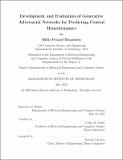Development and Evaluation of Generative Adversarial Networks for Predicting Central Hemodynamics
Author(s)
Khambete, Mihir Prasad
DownloadThesis PDF (5.750Mb)
Advisor
Stultz, Collin M.
Terms of use
Metadata
Show full item recordAbstract
A comprehensive assessment of cardiovascular function requires measurement of central hemodynamic values (e.g pressures in the chambers of the heart and the pulmonary vessels). The current gold standard for obtaining these values is right heart catheterization, an invasive procedure that entails some level of risk for the patient. By contrast, other information routinely used in medicine, namely electrocardiograms (ECGs), routine labs, demographics, family history, and echocardiograms, may contain information that can be leveraged to infer hemodynamic quantities. While there is interest in using such proxy signals to infer central hemodynamics, no existing studies have leveraged these data to provide a comprehensive assessment of patient hemodynamics. This thesis investigates the use of generative adversarial networks (GANs) in combination with cardiovascular mechanistic models to estimate central hemodynamic values from ECG and tabular data. Three hemodynamic quantities form the focus of this work: mean pulmonary artery pressure (mPAP), mean pulmonary capillary wedge pressure (mPCWP), and cardiac output (CO). In addition, we consider methods for evaluating the performance of our networks at the patient level in order to assess their applicability in medical practice. Our models did not achieve good performance on the regression task. However, GANs performed comparably with or slightly better than existing deep feedforward networks on the binarized task, attaining AUC of up to 0.81±0.01 and 0.80±0.01 for detecting elevated mPAP and mPCWP respectively. We hope that this work will ultimately lead to a tool for clinicians to noninvasively estimate a patient’s central hemodynamics in a variety of clinical settings.
Date issued
2022-05Department
Massachusetts Institute of Technology. Department of Electrical Engineering and Computer SciencePublisher
Massachusetts Institute of Technology